17 November, 2004
Romeo, Romeo, Wherefore Art Thou?
Temperature: 18 * F
Location: Lake Hoare
First thing this morning, I went and chipped the ice off the top of the dive
hole. Each night, new ice forms which must be removed so we can access the
hole. Depending on the temperature, the thickness of the new ice will vary.
We seem to typically have about 1-1.5 inches of ice. Once the ice is all
broken up, it must be removed from the hole, so we simply use a fishing net to
scoop it out.
Once the hole was cleared, I set up all the dive gear. I connected all the
hoses to the air tanks and the dive box, got the gear for the back up diver
ready, and did a quick test of all the equipment to make sure it was
functioning.
Ian and I then suited up and prepared to dive. The first job of the
day was for
me to take "Romeo", which is an intricate, remote controlled, underwater camera
to the bottom of the lake. Before I took the camera down, I scouted out an
area that seemed appropriate. The scientists want the camera to be in an area
where they can observe different ages of algal mat and hopefully even catch
some of the algae "lifting off." As the bacteria and algae "breathe", gases
are released which get trapped under the mat. Eventually, enough of an air
bubble forms under the mat that it lifts off the bottom and rises to the
bottom of the ice. Once at there, it gets trapped in the upward movement of
the ice and works its way out to the surface. From there, the algae will get
blown by the wind to new areas offering a food supply to the microscopic
critters in the region.
I successfully deployed "Romeo" to an ideal location. It is a rather large
camera, and setting it onto the algal mat was rather like landing a lunar
module on the moon. Just as the lunar modules wanted to land gently so as not
to "jar" the equipment, the camera had to be placed gently so as not to disturb
the very sensitive algae. It was a successful landing!
After a few other quick tasks, I made my way back to the dive hole. Ian and I
switched jobs, and he dove to collect some samples. While Ian was diving, Jeff
and Tony tried to contact Romeo. There was no contact; Romeo was not
communicating with the surface. Everyone was disappointed, but a solution is
in the works. I will dive again in a few hours and pull the camera out of the
water. Some soldering will get done and hopefully all will be well!
As soon as Ian brought the samples up from the bottom, Kay took them to the lab
and began processing. There is quite an elaborate set up to measure the oxygen
levels throughout the various layers within the mat.
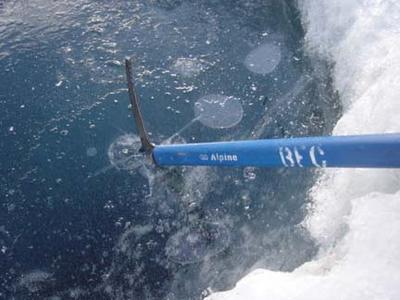
1. The ice axe punching through the "ice over" from the night.
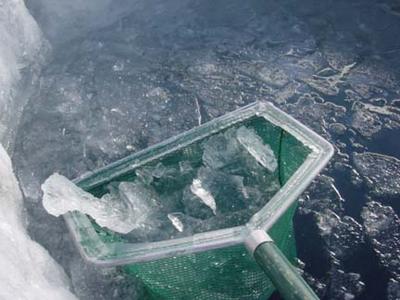
2. Fishing out the ice from the dive hole.
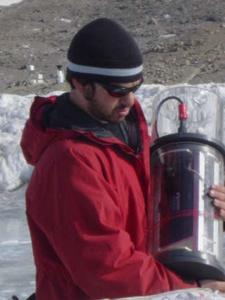
3. Jeff Blair and "Romeo"- the underwater camera.

4. Tony Hansen and Jeff Blair attach some weight to "Romeo" to help sink the camera.
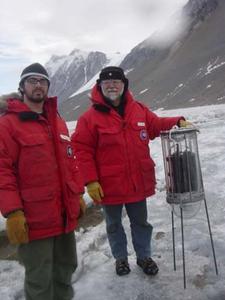
5. Tony and Jeff stand beside "Romeo" for a size comparison.

6. A "pinnacle mat" on the bottom of Lake Hoare; odd, isn't it?
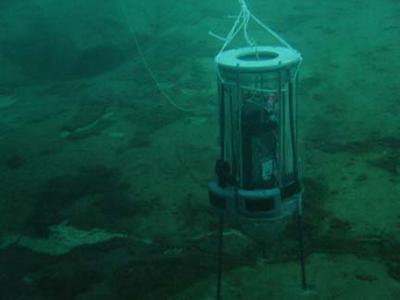
7. "Romeo" in position at the bottom of Lake Hoare.

8. Sand tubes within the ice at Lake Hoare. This picture was taken from within the dive "tube". The channels from the descending sand are clearly visible. Once the sand blows onto the lake, the sun heats it up which causes it to sink into the ice. Empty channels are left above as the clumps of sand descend through the ice.
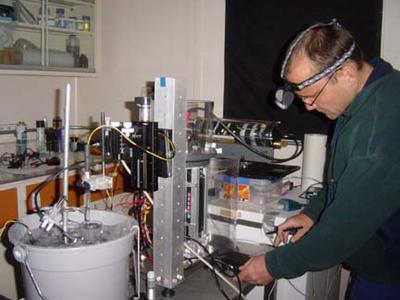
9. Kay Vopel processes the core samples we just retrieved from the lake. On the left hand side, an oxygen sensing probe is lowered into the sample which is contained in the white bucket. The machine to the right of the bucket is computer operated and adjusts the depth of the probe by 100 micrometers each movement. A profile from the surface to the bottom of the sample is then displayed on the computer.
Contact the TEA in the field at
.
If you cannot connect through your browser, copy the
TEA's e-mail address in the "To:" line of
your favorite e-mail package.
|
